Teufelsberg Tale

Remembering life at Field Station Berlin
While Berlin wrings its hands over what to do with Teufelsberg, many veterans who served on the site are watching with interest from afar. After all, those who worked at Field Station Berlin were trained to watch with interest from afar.
Lew McDaniel, of West Virginia, USA, was one of those stationed here between 1968-71, when he worked as a linguist.
He helped organized a reunion of his colleagues in Berlin for the 50th anniversary of the first permanent spying facilities (SIGINT) on the hill in September 2013, when they placed a replica of a commemorative plaque at the site. In Morse code dots and dashes, it states “In God we trust, all others we monitor.”
“It wasn’t an official motto, just one we troops came up with,” McDaniel told Abandoned Berlin. “My favorite is from another installation along the Czech border: ‘First to know, first to glow.’”
The veterans hope one day they’ll be allowed place a permanent bronze plaque at the site.
McDaniel – that’s him to the right pictured in 1967 during his time at Monterey, California – was happy to share some (though not all!) of the details of happier times at the spy station in its heyday.
What follows below is McDaniel’s account of life at Field Station Berlin as told in his own words to Abandoned Berlin.
Secrecy
This is all sort of difficult to discuss since we are still bound by oaths of the time. While the NSA admits it had a presence in Berlin, details are still cloaked. That presence was about 100 of us service types for every one of the (NSA headquarters) Fort Meade folks and without us a great deal would have never been known. They get the credit; we did the work.
While there were certainly very around-the-clock busy times several times a year coinciding with military exercises, I don’t recall during my time any ‘uh oh, the balloon is going up’ incidents. Guys stationed there during the Czech invasion, initial construction of the Wall, and some of the air space issues – they were in tense situations. Nonetheless, anything out of the ordinary sharpened our attention.
We were aware of the situation around us, but really didn’t think about it that much. If we talked about it, conversations were usually humorous in some macabre way. I would say we were more aware of the situation around us in East Germany than troops in other units in Berlin, as well as Berlin citizens.
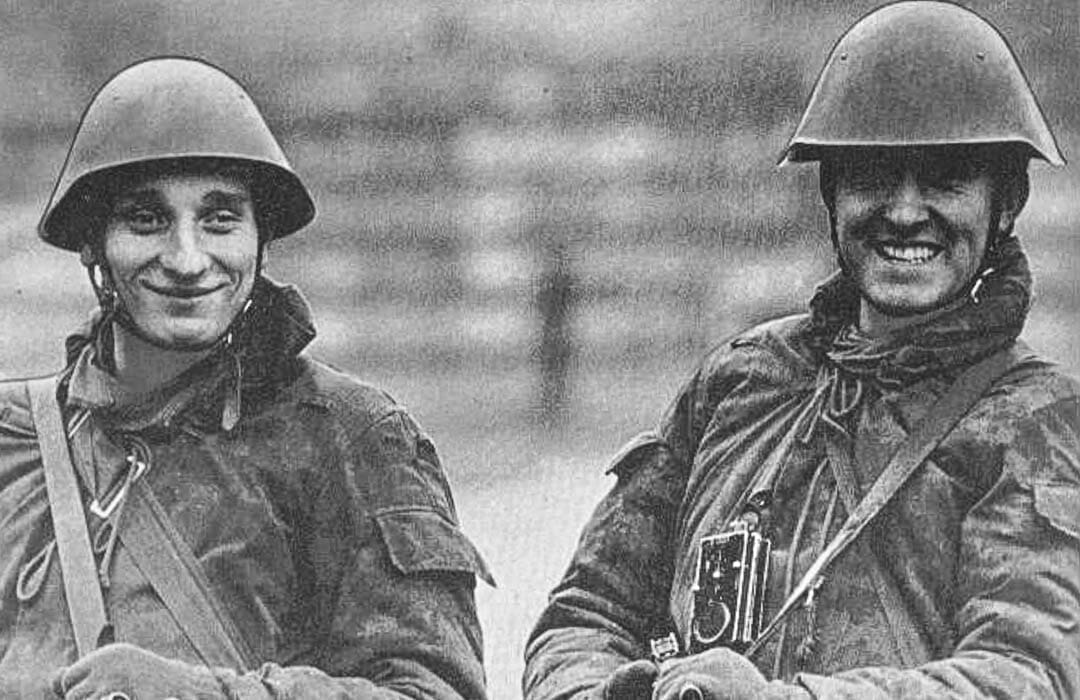
Encounters
For us, it was strange to actually physically see the opposition. I doubt that I saw VoPos (Volkspolizei, the East German police) or Soviet troops more than 10 times during my tour in Berlin. Some were guards at the border where the American duty train changed locomotives. Though forbidden to do so, some traded Playboys and cigarettes and such for articles of Soviet uniforms. I have an East German flag obtained that way. Once in a while, we would see Soviet troops visiting the PX (American military retail store) on Clayallee.
I took some slides of a building just east of the Glienicke Bridge. I was wandering around in that area when I noticed people moving around in the upper stories of a building in the wall and apparently abandoned. I also noticed the windows seemed to be cut straight across. When I got my camera up to take the picture, the people moved away from the windows.
This, I think, is the closest I physically came to the opposition at work (other than the train guards). The building turned out to be an observation post watching US Military liaison mission cars come and go to/from West Berlin.
I think I have to say our mission was somewhat more abstract than that of regular line troops like infantry, armor, artillery folks. Sure, we were trained in basic training like everyone else to fire rifles and such but after that we fired a weapon once a year. Regular line troops did that regularly. In a sense, we were sort of scouts ahead of the cavalry so to speak.
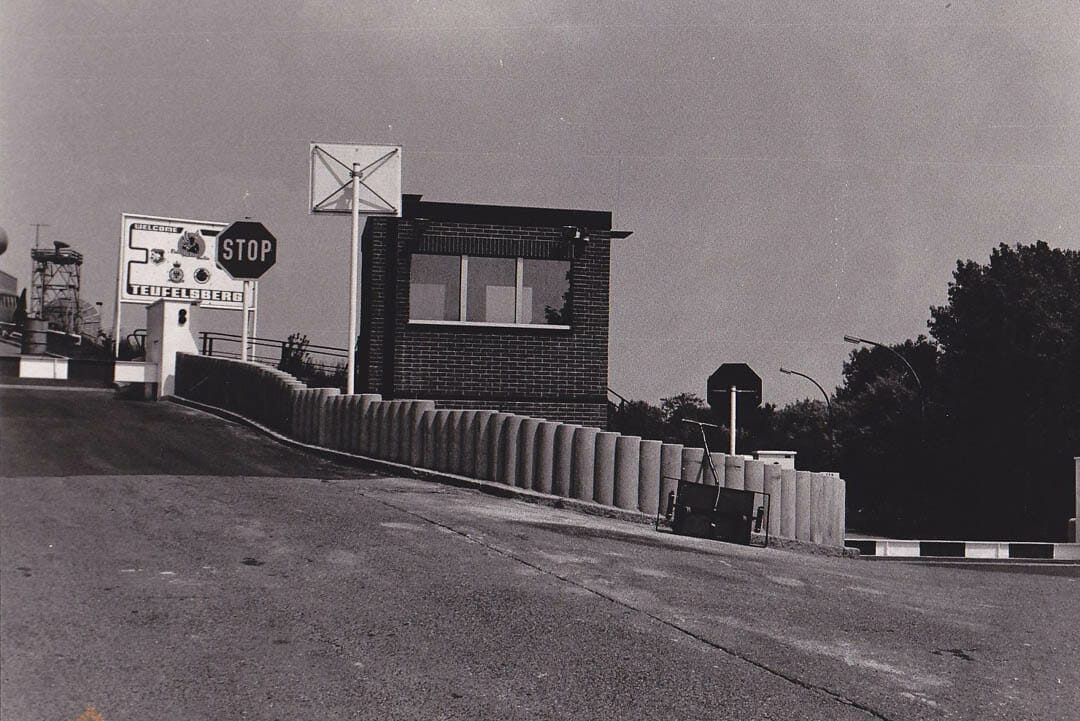
Berlin
It was remarkable to me to see the effects of WWII – houses missing, others pockmarked with bullet holes, the Gedächtniskirche. And I was always aware of what rested under our site. (An unfinished Nazi military training college.)
Years later, my father-in-law and I discussed the city. His view as a WWII B-17 waist gunner on night bombing runs was of course much different.
MOUNTAIN MYTHS
I am sure you have seen all the various T-Berg links on the web. There are a lot of them, some accurate and some not. No submarine tunnel, a favorite while I was there, no aircraft radar, and no secret escape tunnels.
The first site on T-Berg consisted of mounted vans in the early 1960s or thereabouts. I am not sure when the first dome was built, but I think around 1963. During my time there, there was a single dome with metal structures radiating from it. I worked in one of them – hot in summer with no windows we could open and so cold in winter we wore coats, sweaters, and gloves. Gloves made typing very difficult so I cut the tips of the fingers out of mine.
THE BENDS
The dome was two stories atop a concrete central pillar. The dome was made of some kind of rubberized canvas and kept inflated by air compressors from a WWII German submarine. At times the wind would overpower the compressors’ capacity. When that happened, the windward dome side would partially collapse, causing a klaxon to sound. Upon hearing it, we all got outside and away from the structure as quickly as possible lest the dome fall and take everything in it down. The normal air pressure inside the dome was high enough that technicians who had to work occasionally in the top part actually had to decompress on the way out to avoid ‘the bends.’
Grunie pigs
The view from the surface of the Berg (hill) itself was phenomenal on a clear day. At night, we often saw flares firing off along what was then the Wall on the western border of West Berlin. Most of the time, it was caused by animals tripping the flare trigger. Near the site, we often saw wild boars along the perimeter fence.
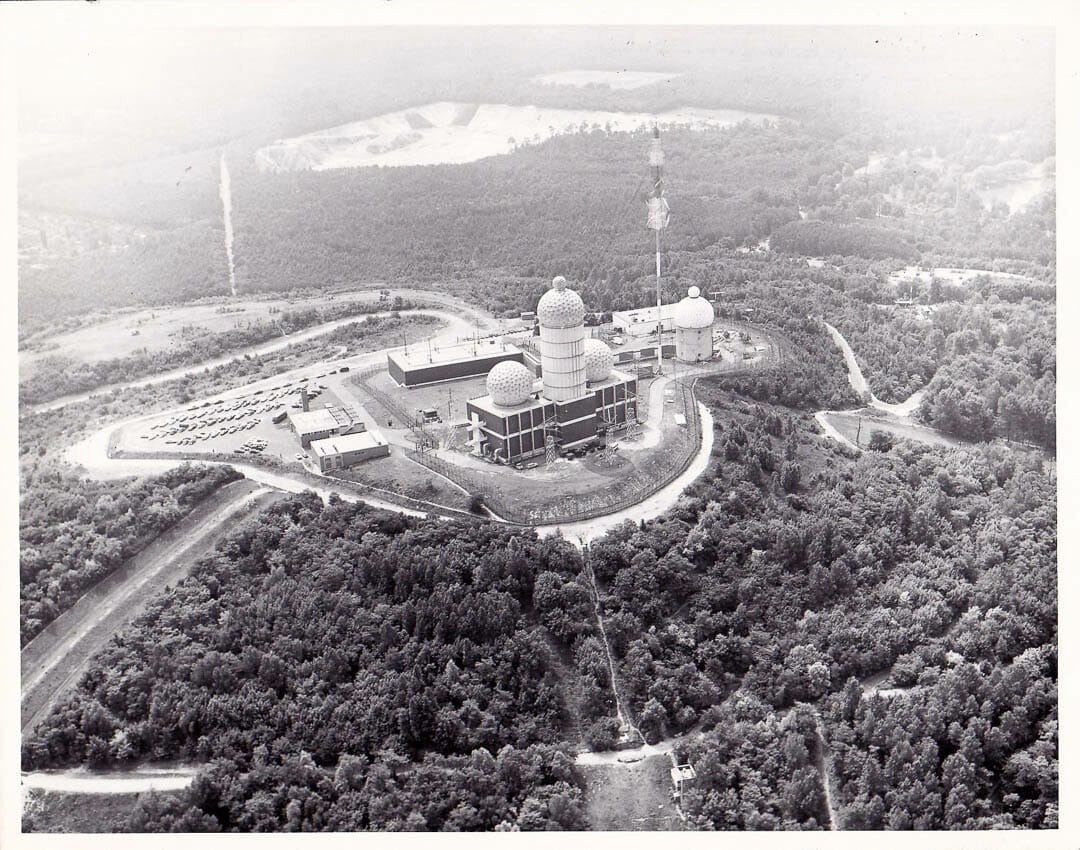
NO PHOTOS
We were cautioned to not be photographed if we could help it. However, Soviet mission cars were in the Grunewald area a great deal and photographed away when they wanted. They were pretty easy to spot – black low grade Mercedes with diplomatic plates and RDF antennae on the roof.
ACTIVITIES
Work there was a mix of excitement at times, coupled with normal business at others. For most of my time there, I worked around the clock regardless of shift when there was urgent work to be done. I remember several three-week stints when I barely bothered to leave. Usually there was an even flow of things to learn and look out for that made the work very interesting – had my wife at the time not wished otherwise, I would have remained in the Army for a career.
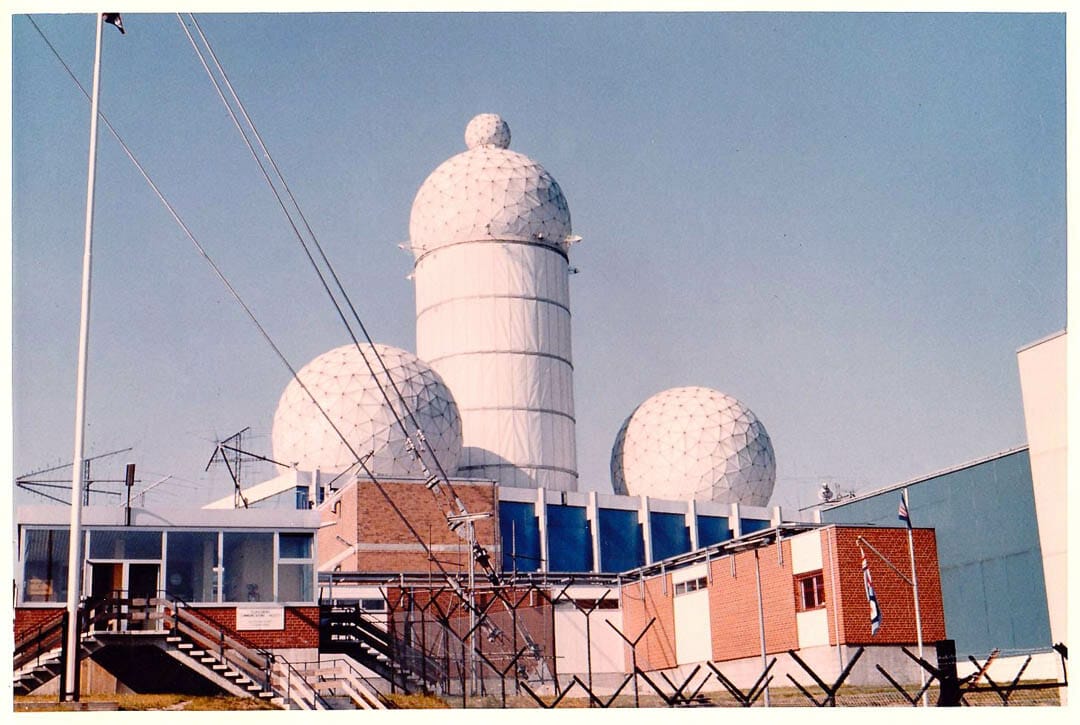
TARGETS
We were keenly aware the Soviets and the East Germans considered T-Berg a prime, first shot target and could have readily obliterated us. Berlin was after all within very easy striking distance of several Soviet tank, artillery, and rocket divisions. Teufelsberg would have literally been vaporized within less than a second after the command to fire was given and that command would have been one of the first.
We were a military installation with concordant rules and regulations, but for the most part we were left alone to do our jobs. While we were certainly in the Army, wore the uniform, and followed the rules for the most part, we did not feel like we were part of the ‘regular’ army that toted rifles and slept in tents and such. I don’t mean to sound like a snob, but our talents were more suited to what we did than to being regular line troops.
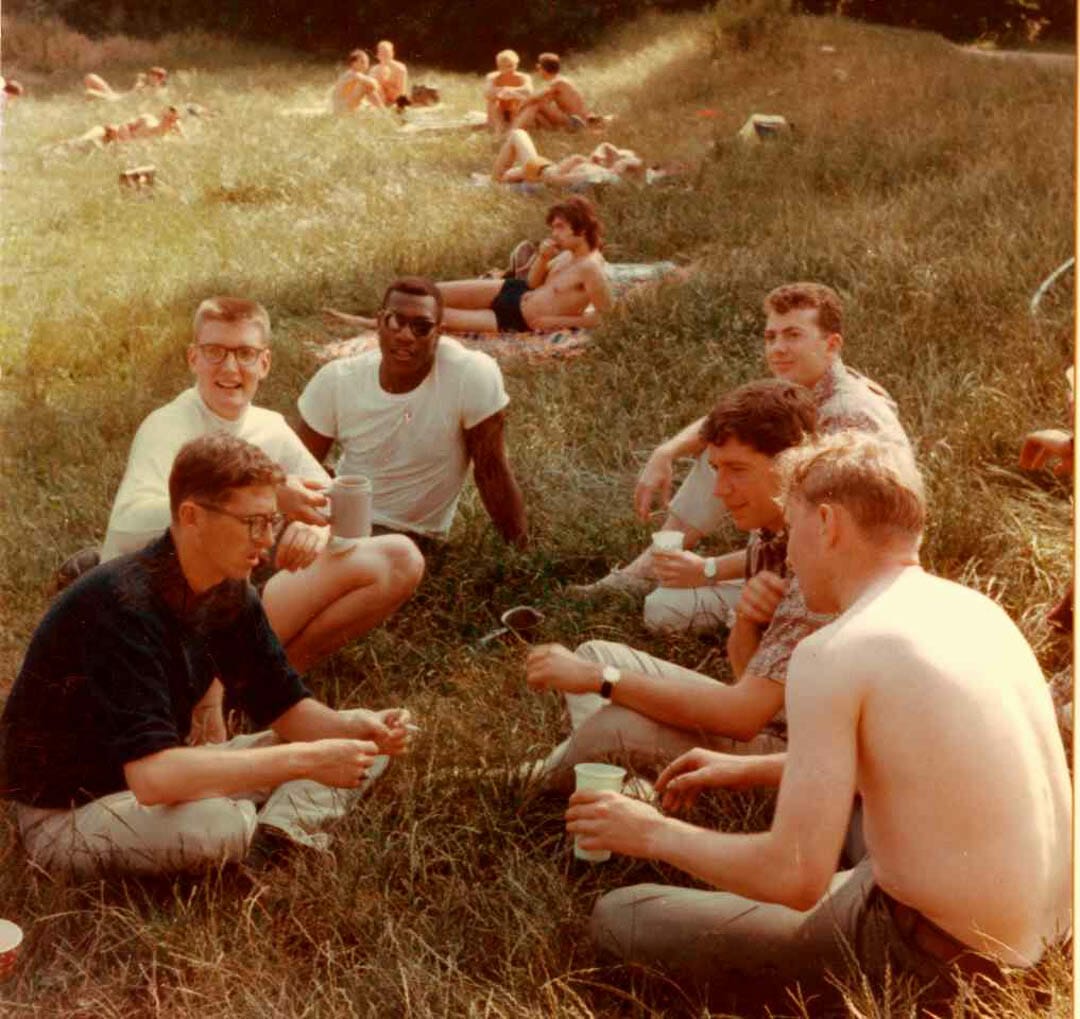
PARTIES
We were also dedicated partiers and nightlife people. We worked rotating five-day shifts and at end of the five days, many folks headed for the bars or to gatherings. Not many folks left Berlin – we could only travel via the American or British duty train or via American flagged aircraft and were not allowed in East Germany or East Berlin – so leaving the city was time consuming.
STEGLITZ
We lived in an apartment in Steglitz, so I was not subjected to life at Andrews Barracks where most were quartered, other than the first week I was in Berlin. My original assignment after language school was to the US Military Liaison Mission in Potsdam. However, the Army realized shortly after that that I was married and changed the orders. Married personnel were not posted to Potsdam.
Living on Maßmann Straße in Steglitz was interesting. I was issued two weeks of C-rations in case the balloon went up and given an airline ticket for my wife for the same situation. I always felt neither would be of any use – see the comments above regarding the forces around Berlin. When I departed Berlin, I had to turn in the rations and the ticket.
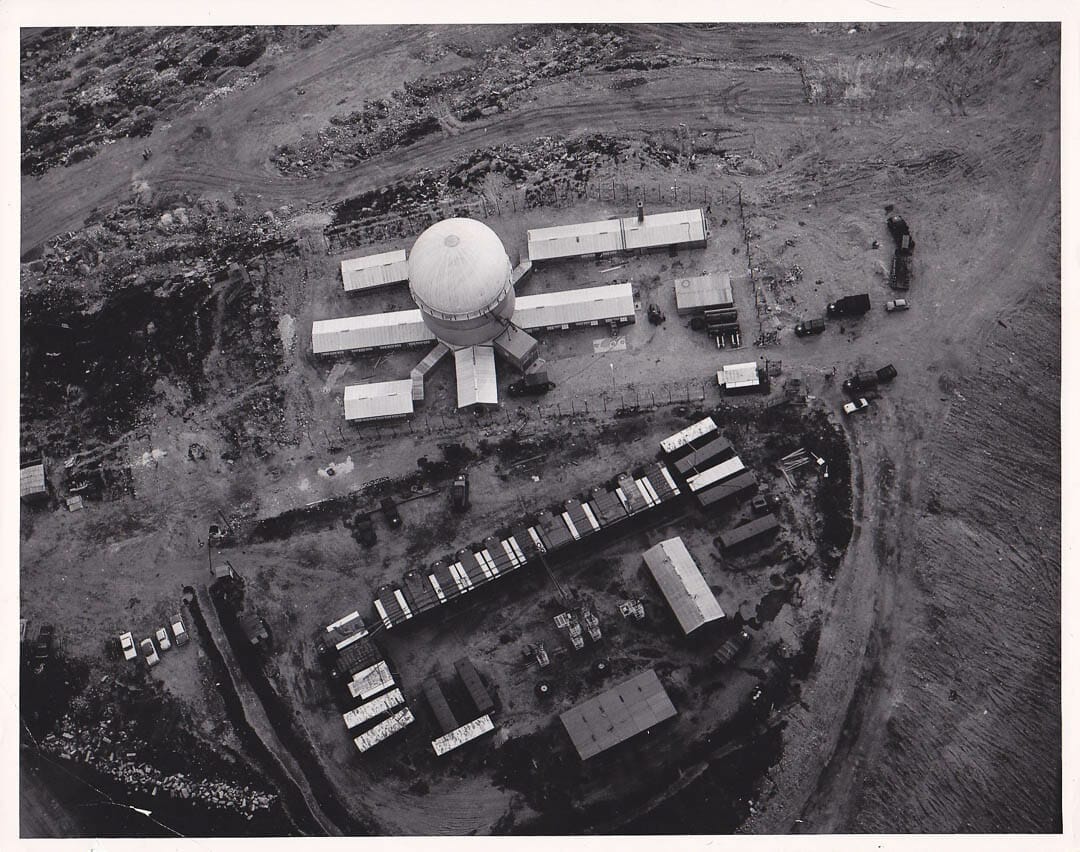
NEIGHBORS
The folks who lived in the other apartments there were nice. We were invited to their parties and family events and we often reciprocated. The Hauswirt and her husband were Czechs who came to Berlin before the Wall was built. We often took them cigarettes, bourbon, and beef and they cooked Czech meals for us now and then. We downed copious quantities of excellent Rumtopf they seemed to always be making
Before that, we lived on a street over off Clayallee in a house that belonged to an old couple who had lived there through WWII. They said their house was occupied at one time by Russian troops who were civil enough, but didn’t seem accustomed to a regular house.
CAREER
What we did and how we did it remains cloaked in secrecy still. I can tell you the Army was in dire need of Russian linguists when I signed up in 1967. Which I did after receiving my draft (conscription) notice – draftees during the Viet Nam war did not usually have a choice of what they did in their two years in the Army, so I enlisted for four years in order to get a better opportunity to do something interesting. I originally wanted to be a helicopter pilot, but discovered during testing for that that I am colorblind and that disqualified me… So I was asked if I wanted to be a linguist. I said sure, how about German, since I had four years of German courses in college. But they needed Russian linguists and sent me to the Defense Language Institute in Monterey, California for nine months. Last time our vets group held a reunion at the institute, Middle Eastern language courses were the largest group – not much Russian taught there now that the Cold War is over.

PRANKS
’Cold War’ is a broad brush that paints over numerous interesting aspects of that time and place.
Humor – a saving grace for us all – had its place as well. There is a tale you may have read about the stovepipe mortar. Reportedly – and there are several who claimed to have witnessed the events and many who don’t believe them – the following happened at one of our sites in the southeastern part of the city immediately next to a VoPo guard tower by the wall. The guards kept a close watch on the site, prompting some jokesters to creep onto the building roof with a long piece of black stovepipe and a beverage bottle painted black. They carefully aimed the stovepipe toward the tower much as one would sight in a mortar. The guards watched closely.
One of the gang carefully raised up and dropped the bottle down the stovepipe like dropping a mortar round down the tube. The guards bailed out of the tower.
ALLIGATORS
I did not mention countless hours of endless boredom, depending on what your specific duties were. I was fortunate there was always something to catch my interest while others were not. Even so, there is nothing like 4 a.m. on a midnight shift after countless cups of coffee to make your mouth feel like an alligator camped in it.
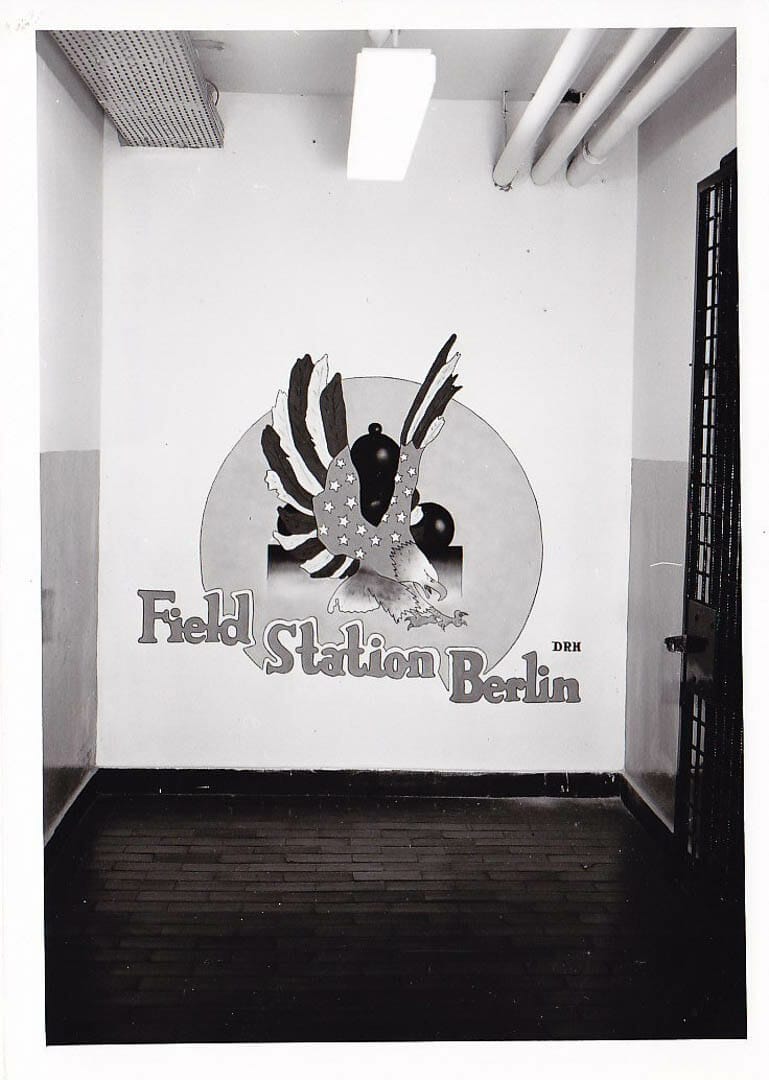
Commies
Regarding our counterparts, we knew we were watched regularly. Soviet “mission cars” roamed the Grunewald near Teufelsberg regularly – black sedans with RDF antennae on the roof searching for radio signals from the site.
During one project I was on around 1970, we noticed the number of Soviet mission cars around the site had increased significantly. That’s when we discovered our CRTs were radiating outside the fenced site perimeter. Had to shut down the project for a week or so until shielding could be put around our area.
We were also supposed to not let ourselves be photographed, beware of who we associated with, forbidden to go to East Berlin, had to fly in/out on American flag carriers, had to ride the American or Brit duty train to get in/out of the city.
Have been following the “what to do with TBerg” issue. Last I knew, there appeared to be some hope at least a portion of the site would be retained. Presumably the portion with the large radome and much “artwork.” I find it interesting that the site is used for commercials, gatherings, and concerts.
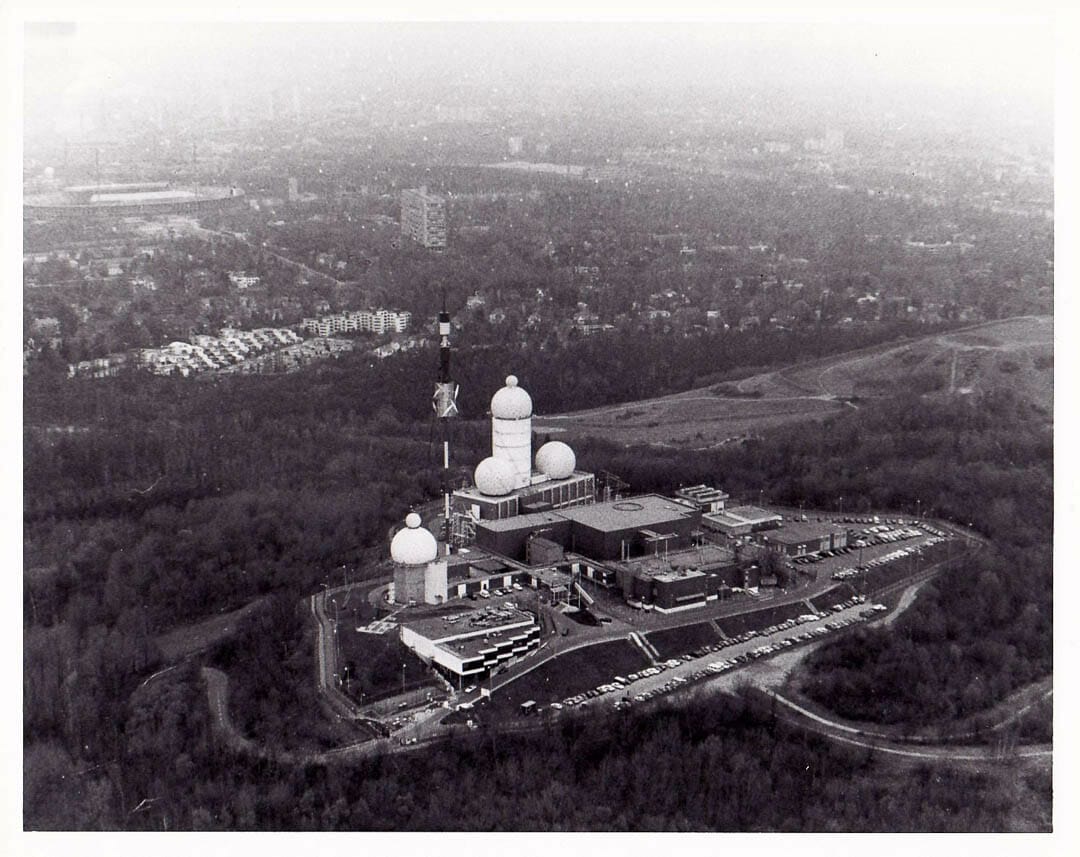
Memories
It has been 47 years* since I arrived in Berlin on the duty train in December. The only thing I recall about that day was the smell of coal burning in stoves and fireplaces. Other isolated recollections of my time there:
- Summer evenings when it was sufficiently light to read outside at 10 pm.
- Riding the Ubahn and Strassenbahn just to watch people. And a little old lady who stabbed the Umsteig I had dropped and took it as her own.
- Folks strolling in the forests on sunny Winter days, often with their dogs.
- Dining outside on the Kdamm on warm evenings.
- A bar in the Tempelhof area where the street walkers hung out. Good food, strange people. There was also a pizza place near there called “The Dirty Old Man”. White asparagus on the pizza he said he got out the ditches in the area.
- Rosario’s Pizza. We would make up an order on the Hill and someone would drive to Rosario’s to pick it up. If we ordered three pizzas, we got a free bottle of Lambrusco which was often downed while returning to the Hill with the order. And yes, I made a few of those trips.
- The NAAFI. Great single malts and cognac for very little money. I still have the Harris tweed jackets I bought there. They no longer fit, but I can’t bring myself to give them away. They also ran “the NAAFI wagon” that came to the Hill at lunch time during the day. Excellent NAAFI wagon food, although I can’t say the same for the NAAFI itself downtown…
- Getting off the trick bus at Randy’s on Finkensteinalle, heading inside, and not coming back out until 2 days later when the trick bus stopped to pick us up.
- The hauswirt on Massmann Strasse where we lived. She and her husband were Czechs. I would bring them Jim Beam bourbon and beef. They would cook dinner for us and her family, after which we drank the bourbon…At the same location, our apartment opened onto a courtyard shared with other buildings. On pretty days, someone in the other building would play recordings of various operas. I am not an opera fan, but somehow that seemed just right.
- Unrepaired bullet holes on the fronts of buildings in the various areas we lived. Missing structures removed by bombs in rows of apartments…
- Listening to our landlord tell us about Russians living in his house near the end of the war.
- Also at the Massmann Strasse location, the building had an inner courtyard. One very hot Summer day, I saw workers moving a piano into the courtyard near another entrance that led to the upper floors. They put a long wide canvas band around the forehead of one burly fellow who was bent over. Then they tipped the piano vertically onto the loop formed by the band. He stood up straight with the other guys balancing the piano on the band and against his back… Up the stairs he went, piano in the loop around his head with the other guys behind him… I got a fistful of beers from my fridge and followed them up three flights. They did not stop until they reached their destination. I handed out beers, which they really appreciated.
- In my time there, I never ran into any male who would admit having fought in the West. East, yes. West, no.
- We linguists didn’t have to do much that was truly military. But once a year we did have to fire our weapons for record and we did have to be tear gassed. In basic training, there had been some debate about whether I was to be a linguist or, due to most excellent marksmanship, a LRRP (called a “lurp” – long range reconnaissance patrol, often a sniper).Fortunately languages won the day. Anyway, at one of our annual firings in Berlin, the fellow next to me managed to somehow get his rifle on full automatic which we were not supposed to do. He did not realize he had done it. When we began to fire, his rounds went high into a metal super structure over the range (automatic weapons rise when fired on full auto and you have to watch out for that) and ricochets went everywhere, sending us all diving to the ground. We remembered that the next year and no one would stand anywhere near him.
- The day I left the Army, July 11, 1971, I mustered out at Ft. Dix NJ. I had not taken leave the entire 4 years of my service, so I was paid for that time – $6000+/- in cash. After mustering out, I went to the Philadelphia airport to await my flight home. Like many other GIs who were doing the same thing, we sat in a bar and waited for our flights. I noticed that every few moments, we all did the same thing – checked our pockets to make sure our money was still safe. The other day I was talking with a vet friend of mine who mustered out in Oakland, California and he related the same pocket checking going on when he was getting out.
Funny the things we remember.
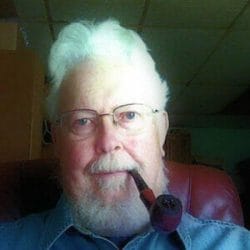 McDaniel left the US Army after his three-year tour in Berlin was over. He taught Russian at West Virginia University for a while, and eventually retired as its computing director in 2000.
McDaniel left the US Army after his three-year tour in Berlin was over. He taught Russian at West Virginia University for a while, and eventually retired as its computing director in 2000.
In 2015, when he first spoke to Abandoned Berlin, he was living with his wife 26 miles south of Morgantown, West Virginia, in the middle of a forest. They’ve since bought a place in town.
*It’s now 55 years since he arrived in Berlin on the duty train in December. He still follows TBerg developments from afar. “Sure has been a twisting road.”
All photos (except those of Mr. McDaniel and the soldiers, which Mr. McDaniel himself provided) were very kindly provided by the US Army Intelligence & Security Command. Many thanks especially to Mike Bigelow for his assistance.
Filed 29/10/2015 | Updated 16/5/2023
Spies who came in from the cold…
Teufelsberg
The abandoned NSA Field Station from the frontline of the Cold War, used to spy on Soviet-controlled East Germany on the other side of the Berlin Wall.
Stasi Hotel
East Germany checked out right before the Stasi could check in. Their hotel was never completed. Now it’s just a great hulking ruin between the trees.
Stasi spy station
The Stasi spy station Quelle 1 in Rhinow tapped fiber cable going from West Berlin 250km across the DDR to enemy state West Germany. Sneaky.
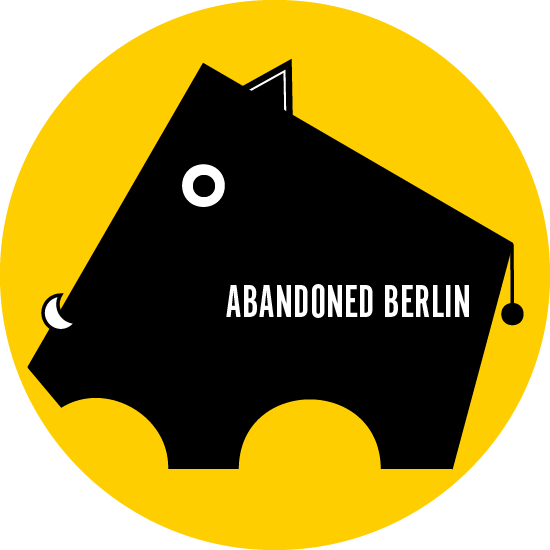
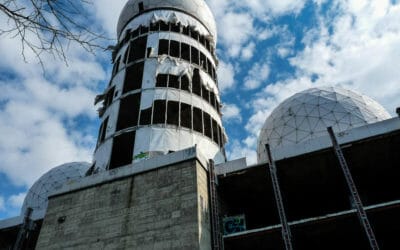
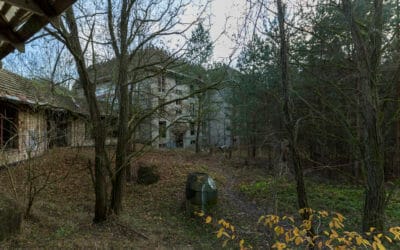
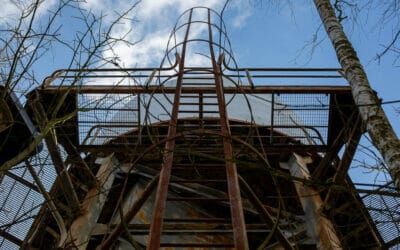
I got some Teufelsberg maps (not very interesting ones, though) by sending a FOIA request to the NSA. Maybe you could get more information about what they did and how using that procedure. It’s relatively easy and often free of charge…
Keep us posted if you do!
Hey IB, we’re currently hanging out in Berlin and have been using your page for information – thanks a lot dude it’s very informative- anyhow I wondered if you had any more recent information on the guarding situation here. We can’t seem to see anyone on site and wondered if you knew if there is anyone actually staying onsite atm? I think we’ve twigged onto a someone leaving the site this morning but we’re unsure if it’s just a patrol van passing by or someone actually onsite? Here’s hoping you have more info 😀
Just for extra info for you, we used your guide for Heilstatte Grabowsee and found that the guard wasn’t there when we arrived. We snuck in and wrote up some helpful hints in our blog. I’ll update in a comment on the HB info for you 😀 Toodles x
My father now deceased worked there from 62-78 apart from about 3 yrs
We lived at RAF Gatow
He was a Russian linguist
I have an elevator key and a metal, “In Case of Fire Do Not Use Elevator” sign…
I was stationed there from 1977 – 1980. It was a joint site with the British since it was built in their section of the city. Not sure about the Nazi college but the hill was primarily composed of ruble from the ruins from the city. I dug a horse shoe pit near the building and dug up street signs, pieces of buildings, etc. at about 6 to 10 inches down. When some of the other guys put up a basketball goal they dug up an old manhole cover. I was fortunate in that I was assigned brand new family quarters for me and my family. I lived on the 6th floor and could see the wall from my balcony. If I had the funds I would love to go back now and see what has changed. It is sad to see the site so deteriorated now.
I was there during the 70s and partied in Berlin. My duties were compartmented and of course part of an elite activity. Time goes on and ironically work at a desk called Berlin Wall currently. Yes, the government location has a portion of the wall displayed. What a great memory.
Hi, Lew! Need help or ideas, please! I ‘m Jim Passarelli/ [email protected] and I served at FSB/Teufelsberg as a Russian linguist from April of 1972 until the end of September 1973. An FSB colleague from 43 years ago contacted me on Facebook this past Thanksgiving and we are trying to reconnect w/ other colleagues. Not an easy task, as I am trying to contact over Facebook where correct name spellings are critical to success. Any thoughts would be greatly appreciated
I worked on the Hill in the mid to late 70s. Yes it is sad to see our old duty station in such a dilapidated state, but one can also look at it from a point of view that its condition means that our mission was ultimately successful. I have to admit to making use of West Berlin’s social scene which was pretty wild during those halcyon disco days.I do know that we who were assigned to the Field Station took great pride in our work and fell in love with the remarkable city and its people. It’s ironic that I owe the happiest and most adventurous time of my life to communism and the Cold War.
I also served there.It was a blast.
Hello,
I am a student of journalism. I choose to make a mini documentary about Teufelsberg as my graduation project. I would like to mention also history of this place – mainly it would be showen as a street art heaven. If your father worked there and still live in Berlin..would be great to heard something what he experienced. Please contact me klarajanikova[at]gmail.com
I was stationed at Teufelsberg on the US side from 1987 till 1990 the very end. I recently watched the german film under the same sky and became curious what kinds of attempts were made to compromise us during my time there. I haven’t found anything.
I was there from 1986 to 1989
I was there about the same time, never heard of any such films
Was there today and it’s been allowed to turn into a real shit-show by the people entrusted to operate the site. Trash everywhere, food left on tables, broken bottles everywhere, hazards of all types because they’re just too lazy to correct, and debris of all sorts. Not a finger appears to have been lifted to set any kind of long-term rehab goals or at the least make the place presentable. It’ a real shame.
What a wonderful experience FSB. I was there as a code interceptor in the early 80’s before volunteering for SFAS. I used to ruck at sunset from garrison thru the Grunewald. Frequently threaten by wild boars and once followed and stopped midway thru the forest by the local police. They couldn’t believe a person would be trekking in that area alone at night. However, no hassle, they wished me well and a safe journey. Of course they had known my purpose and where I worked.
No worries mate, it’s the memories that remain. Everything else normally returns to dust or shit
As an O5H/98H3 I left in 87 for SFAS
I served in Berlin. My son was born there.
Very interesting. My father worked here for one or two tours of duty. He was never able to talk about what he did, so this article filled a big void for me. Thank you!
Station at FSB as 32F 1972-1974. Great people dedicated to getting the job done, although most of us just tried to avoid draft unsuccessful!
Was stationed at FSB 1968 to 1972
assigned to Rudow (Site 1) Golf experiences and fond memories.
beautiful city
Worked at “site one”. Rudow from 66-69. Sp6 Joe Lumpkin. I actually dreamed about it today in nap time.
Assigned to FSB 620K from 1969 – 1973 and worked in the Octopus and in Stackpole; Branflake and Skateboard and loved it. Read all traffic out of FSB which only summarized what we actually caught. Liked reading all the teletype for UPI and seeing difference that the editors made to what was submitted to papers. Was 98G and 48B and 96D before becomming 35D as officer.
I worked there as a contractor for ManTech. I worked from June 1980 t. June 1982. It was a great two years there. My first daughter was born there in November 1980.
I was stationed there from Aug 77 to Mar 79. Was a 35B, test equipment repair, and worked on the first floor in maint shop. Just recently returned in Oct 2022 with BUSMVA Group for an 8 day visit. I was very saddened to see the condition of the hill and was not allowed to go on the first floor to visit my old work area. They still had good beer and wurst.
I worked there from 72-74, in German intercept. Visited the site last year and was amused to see the ruin is basically a giant street art installation. They charge 8 euros to enter and walk about. Curious why they don’t demolish and repurpose the hill. However, I think it does get plenty of curious visitors.
Mark, just visited Berlin in September and met up with Charlie Kinder, Tom Gallant and J.D. Wilson. Visited. Teufelsberg with my two sons, and we got in free after I told them tha I worked there. My younger son and I actually got a room at an apartment complex directly behind Andrew’s Barracks.
Hi Lew,
Just checking in to say hello. Hope all is well.
I was at FSB from mid-‘68 to mid-‘70. My last assignment was as CO of B Company. Your A Co. CO’s were George Williams and later Bill O’Neill. Bill has passed on.
I live near Richmond, VA and just turned 78.
Andy
Hi Andy,
Great to see your comments. I was in B co from 66 to 70 and remember you well. I see George M., your friend and predecessor often in Boston. We reminisce a lot about our time in this wonderful city. I also remember the stovepipe incident and believe it’s true.
Best regards,
Ralph
I was in B co from 69 to 72 assigned to Site 1. The co of B co was George Mooza and the first skirt was Mclwrath. They were later followed by Andy Fraser and Sfc
anderson. col hamster was the co of FSB
I was fortunate to be assigned as one of the MP’s to FSB from 68-71. We worked all 4 sites, which included the “cage”, where I worked for a year or so.
I also traveled the duty train as security, back and forth to Frankfurt. It cost me a few Plaboys and pistol lighters, but I still have my Russian belt. I ended up marrying a Berliner and subsequently lost my clearance. I then drove Col. Hamilton around until it was time to get out
I was assigned to the Army Security Agency Field Station Berlin HQ com in 74 75 76, I worked in the com center on both the hill and in the tin can at the barracks HQ ASA at Andrews which was dismantled in 75. This was a steel shed inside HQ company that was a direct link to the commanding officer. I was part of the group that dismantled it. We were told we had 2 weeks to dismantle it, every day before it was sched to be dismantled we would be given leave. We dismantled it in 3 days. I am close to 69 years old and do not remember many names from back then. But I do have a interesting story to tell. We removed all the equipment and were ready to rip the power panel off the wall, the Sargent I was working with asked the the other 2 sergeants if the power was connected. The yelled back ok you are good to go. we took a 6 foot crowbar and jammed it between the wall and the power box……. I do not remember much but i saw nothing but black, I remember saying to myself, well i think can i feel, can i move my arm can i move my leg, then i heard my Sargent WTF I THOUGHT YOU SAID THE POWER WAS TURNED OFF. When i regained my senses i was a good 15 20 ft away from the power panel. i still do not remember what happened during the black out.
Wow, what a story! Would love to hear more 🙂
I have many many memorys of THE HILL. i was with the HQFSB from 1974 to1976, HQ company, and worked in the com center.
I was stationed in USAF at Tempelhof 61-63. I was in 1946 comm sq air control center, and had many friends in 6912th I Loved Berlin–awesome duty. Love to read your comments. I feel we are all brothers. I was proud to serve
I was there from Oct.65 until June 68. Construction had just started on a brick building. One day one of the German construction workers asked one of the people on guard duty why they were carrying loaded M14s. After being told it was to keep them from going into the “spider building”, he replied ,”none of us want to go in there, everyone who goes in there comes out crazy.” I worked the pit, 98G3L63. The locals referred to the site as “the big ear that listens to the east”. I wonder what they called it after all the building was completed.
there is a lot of movement at the old fsb these days. i heard rumors the station is back on the power net after many years without power. water supply will also come back up the hill asap. a small team of of field station Teufelsberg lovers (Interessengemeinschaft Teufelsberg, Alliierte in Berlin e.V, ++) are working hard. the museum/exhibition of allies in Berlin e.V will also come step by step back to life up the hill in the beginning of 2024 as I heard it right.
everybody whose coming up the hill is welcome but veterans are always free of charge if they‘ll let the staff know.
It’s still such a unique place !
I was stationed in Berlin from 1984 – 1987. I was assigned to the 766th MI Det. My late wife was assigned to FSB. I used to travel there frequently to conduct background checks for security clearances for personnel assigned to FSB. I used to give SAEDA (subversion and espionage directed against the US Army) briefings to the soldiers assigned to FSB. One of the soldiers that attended a briefing came forward and reported a contact from soviet personnel. The lengthy investigation finally resulted in the apprehension of 3 KGB officers that our detachment carried out. It was arguably the most fascinating 3 years of my life. My current wife and I recently (June 2023) returned to Berlin and toured FSB (Sunday afternoon english tour). As part of this tour the guide talked about this operation I was fortunate enough to be a part of. He allowed me to tell the story of how the investigation played out. It was a fascinating trip down memory lane. I would highly recommend it to those that spent time there.
As a 2LT, I and my wife arrived in Berlin and our sponsor met us at Templehof in May 1970. The first few nights they put us up in Dahlem Haus, near the Harnack House, officers club. I still have my membership card. I was assigned to HQ Company Berlin Brigade, AG (lucked out from ROTC summer camp,) and we lived in a wonderful two-bedroom apartment, cornered by Argentinische Allee in the south and Clayallee in the east, a short walk to work at Berlin Brigade HQ.
My first assignment was Custodian of Classified Documents so I had clearances up the wazoo. Don’t remember how many docs we managed but I and my staff of five worked in a double combination vault, maintaining inventory, constantly counting the right number of copies, signing docs out and when the docs were no longer needed, tossing them in burn bags and watching them go up in flames in the incinerator.
Like others with secure positions, we could not travel to East Berlin or drive the Autobahn to the west where I got my Soviet belt at the Russian checkpoint leaving Berlin. I was relieved after 9 months to be Postal Officer for USAB. Now we could drive to West Germany and beyond and go to East Berlin. (Remember flag orders?)
Our fondest but saddest activity was sometimes having nothing to do on a Saturday afternoon, before partying with friends, driving our VW fastback in any direction till we hit the wall and drove along the wall to a viewing platform where we’d climb up to view the guarded no man’s land and sadly watch families in the west shout to family in the east who had not gotten out.
I still have four other officer friends of 55 years who we remain in contact, one a retired full bird who stayed in, who lives in Austin TX, considered my closest friend. We get together every year or so.
I was assigned to Berlin’s Rail Transportation Office and then a special project in the period that Lew McDaniel described here. I’ve been back a half dozen times since and it is always interesting. There are places that I photographed in 2002 that are gone now. ASA people in particular might be interested in an article in my website about communications between West Berlin and West Germany. Let’s see if this link works:
https://www.berlin1969.com/stories-geschichte/over-the-top/
Thanks for that tale, love T-Berg …
Frank
When someone is interest to get the
FIELD STATION BERLIN PATCH
Can contact me at
[email protected]
1974-1979 Yes, five years there. It was an amazing collection of great memories for me, personally, and for my five-year old son, [now 54 years old]. 98G German linguist with Branflake. It was my honor to be assigned there for the 5-yr duration, while I was able to complete BA [Univ of Maryland} and MA work with Boston U. It was so preferable to other assignments re: the EW side of my MOS at Fort Hood, TX or Reforger. All of the experiences were unmatched, the beer parties [Schultheiss beer], the West German [Berlin] folks and their hospitality. I also learned first hand that the nude beach on the opposite side of the lake was not all that ‘sexy’. It was also bazaar during the visits I made to the observation platforms at Brandenburg Gate, among other sites; to be looking across the wall, concertina wire and tank traps and dogs while people on the East Berlin side stared at us from their one-and-only observation platform. Of course, the guards in the towers were not primarily looking at us but to make sure their own citizens did not try escape. To those of you who served, thank you. I know you sacrificed (most of you} three years and probably some of you have endured “hearing” loss. I was “Omar” and my best friend was Big Bobbert. All of us collected the jokes [some were funny] spoken by our adversaries and was saved in a Pass-On Book. And I am grateful to each of you for sharing some of your experiences there.
I was assigned to FSB from Oct. 1970 – Oct. 1975. I was a 98C in Orange section.
Interested reading and brought back some good memories. Berlin is kind off a second home. I was there from 1966 to 1968 and graduated from Berlin American High School in 1967. I came back in 1979 as a 98C. Most of my tour was as Team 4 Watch NCOIC. My last 90 days there was very eventful as my daughter was born. Also I will say thanks to the MPs on watch as they were able to hold off a German armed guard from entering the building. Two of them were outside with him and the third was inside refusing to push the buzzer to let him in. It all ended when the MP NCOIC was able to knock him down and grab his M16. I also wish remind Team 4 members that you had the best record of the four teams. REMEMBER THE TWO Travis trophies awarded to the station. “ON WATCH”